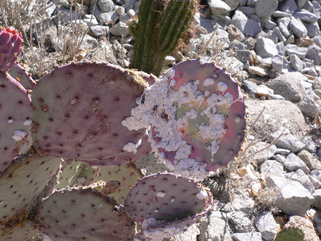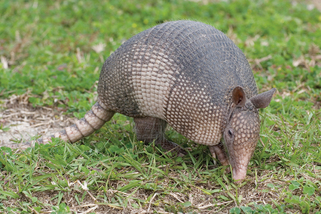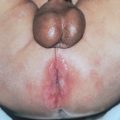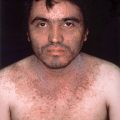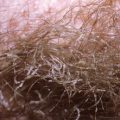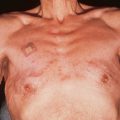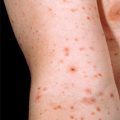Chapter 69 Dermatologic trivia
1. What does the X in histiocytosis X mean?
It expresses the common etiologic link among the three clinical forms of the disease: eosinophilic granuloma, Hand-Schüller-Christian disease, and Letterer-Siwe disease. When Louis Lichtenstein coined the name histiocytosis X in 1953, he chose the X to represent the then-undetermined cause of the disorders. He wrote that the suffix X “has the advantage of brevity and, by implication, emphasizes the necessity for an intensive search for the etiologic agent.” We now know that the common link is a proliferation of dendritic cells that are ultrastructurally and immunologically similar to Langerhans cells. Indeed, they probably are Langerhans cells, as reflected in the current name for histiocytosis X—Langerhans cell histiocytosis. Much about the disorder is still unknown, so perhaps Langerhans cell histiocytosis deserves to keep an X-designation.
Lichtenstein L: Histiocytosis X, Arch Pathol 56:84–102, 1953.
4. Several names are used for the disease caused by Bartonella bacilliformis: bartonellosis, verruga peruana, Peruvian warts, Oroya fever, and Carrión’s disease. Who was Carrión?
Daniel Carrión studied the relationship between the disfiguring, but seemingly benign, cutaneous disease verruga peruana, and the often-deadly disease Oroya fever. As part of a student research competition in 1885, the 26-year-old medical student inoculated himself with the blood of a patient with verruga peruana. Carrión soon developed the malignant form of Bartonella infection, Oroya fever, characterized by high fevers, severe myalgias, and profound hemolytic anemia. He postulated that the two conditions were related, but his experiment sadly ended fatally. A few decades later, his theory was proven correct, and now Carrión is the hero of the Peruvian medical profession.
Leonard J: Daniel Carrión and Carrión’s disease, Bull Pan Am Health Organ 25:258–266, 1991.
5. What other illnesses are caused by Bartonella species?
Cat-scratch disease is caused by B. henselae, and trench fever is caused by B. quintana. Other conditions caused by various Bartonella species (including B. henselae and B. quintana) are most common in immunocompromised individuals, particularly those with HIV infection. These conditions include bacillary angiomatosis, peliosis hepatis, and a form of culture-negative endocarditis.
6. Sporotrichosis is also called “Schenck’s disease,” and the causative organism is named Sporothrix schenckii. Who was Schenck?
The disease is named after Bernard R. Schenck, who described the first definitive case of sporotrichosis (in an arm) in which the fungus was also isolated from the patient. Schenck was a second year medical student at Johns Hopkins Hospital when he made his famous discovery. The fungus could not be identified and was sent to Dr. E.F. Smith at the United States Department of Agriculture. Based on the colony appearance and microscopic morphology, Dr. Smith considered the fungus to be a species of Sporotrichium. In 1900, Hektoen and Perkins described a case of sporotrichosis in the finger of a boy who had struck his finger with a hammer. They reported the case as “Refractory subcutaneous abscesses caused by Sporothrix schenckii” and Dr. Schenck’s name became forever associated with this fungal infection. Dr. Schenck did not become a dermatologist and reportedly specialized in obstetrics and gynecology after medical school.
7. What is the difference between Klippel-Trénaunay-Weber syndrome and Klippel-Trénaunay-Parkes-Weber syndrome?
There is no difference. They are examples of eponymy with synonymy; both refer to osteohypertrophic nevus flammeus or angioosteohypertrophy syndrome. The medical literature contains many reports, erroneous but oft-perpetuated, that distinguish the two as different syndromes on the basis of limb-length discrepancies. Weber and Parkes-Weber refer to the same person: Frederick Parkes Weber (1863–1962), an Englishman who was a consummate physician and erudite collector of unusual medical cases.
9. What is ciguatera poisoning?
Ciguatera poisoning is caused by ingestion of ciguatoxin, a tasteless toxin produced by dinoflagellates (Gambierdiscus toxicus). Humans are affected by eating carnivorous fish (such as barracuda or red snapper) that have accumulated the toxin as it is passed along the oceanic food chain. Ciguatera occurs along coral reefs in tropical or warm subtropical waters. Ciguatoxin interferes with sodium channels in mammalian cell membranes. There are a number of gastrointestinal symptoms, but the occasional fatality is usually due to cardiorespiratory involvement.
Lange WR: Ciguatera fish poisoning, Am Fam Physician 50:579–584, 1994.
11. From what is cantharidin made?
Cantharidin (C10H12O4), a vesicant therapy for molluscum contagiosum and warts, is a semipurified extract from blister beetles. The compound induces a blister at the epidermal–dermal junction. Blister beetles, mostly in the family Meloidae, have been used in Asian folk medicine for millennia. In the southern United States, horses are often afflicted with cantharidin toxicity after inadvertently eating the blister beetles that live in mowed alfalfa.
13. Seriously now, cantharidin has been confirmed as an aphrodisiac. Who uses it and how does it work?
18. Why does Jonathan Hunter’s name grace this ulcer?
Jonathan Hunter was one of medicine’s most influential practitioners. Among his works is the treatise “On the Venereal Disease,” which addressed the then-unanswered question of whether gonorrhea and syphilis were different expressions of the same disease. Hunter attempted to settle the issue by inoculating himself in this manner: “Two punctures were made on [my] penis with a lancet dipped in venereal matter from a gonorrhea.” Unfortunately, the donor of the “venereal matter” had both gonorrhea and syphilis. Hunter soon developed a chancre on his penis and later developed secondary syphilis. The mistaken conclusion of his little experiment was that gonorrhea and syphilis were the same disease. Incidentally, Dr. Hunter died 26 years after his self-inoculation from classic syphilitic heart disease.
19. Mucicarmine is a histologic stain used to detect mucin. From what natural source is mucicarmine obtained?
Cochineal, which is produced by a mealy buglike insect (Dactylopius coccus) that lives on several species of cacti (Fig. 69-1). The pigment’s chemical properties serve as deterrents against predation by other insects. Cochineal dye is crimson and has long been used as a traditional textile dye in Mexico. Emily Dickinson described the colors of a ruby-throated hummingbird as “A resonance of Emerald/A rush of Cochineal.” Check the ingredients on bottles of pink grapefruit juice and you’re likely to discover that the pinkish-red color is conferred by cochineal-laden bug poop.
20. How does the Food and Drug Administration differentiate between an underarm deodorant and an underarm antiperspirant?
Deodorants are cosmetics that control, obscure, or mask body odor. As a cosmetic, it has no claim to alter the body’s physiologic process of perspiring. Antiperspirants alter the natural process of sweating and are therefore considered an over-the-counter drug. Antiperspirants are often deodorants, too.
Schoen LA, Lazar P: The look you like, New York, 1990, Marcel Dekker.
21. What is Compound 606?
Also called salvarsan, Compound 606 was introduced to clinical medicine by future Nobel-laureate Paul Ehrlich in 1909. It was long considered the drug of choice for treponemal infections such as syphilis and yaws. The name reflects its place as the 606th compound tested by Ehrlich and his partner Sahachiro Hata. Ironically, salvarsan was developed not as a treatment for human syphilis but as part of an experiment on murine trypanosomiasis.
22. Who was James Lind?
James Lind (1716–1794), British naval surgeon, has received an inordinate share of credit in establishing the preventive and curative role of citrus products in the management of scurvy. Although Lind believed scurvy was caused by clogged skin pores, he conducted several shipboard trials of alleged antiscorbutic substances, leading to the use of citrus products (limes) by the Royal Navy during long voyages, hence, the moniker “limeys” for British sailors.
Carpenter KJ: The history of scurvy and vitamin C, New York, 1986, Cambridge University Press.
23. If citrus products prevent scurvy, why did the Royal Navy suffer from so many scurvy outbreaks a century after Lind?
Not all citrus fruits have high amounts of vitamin C. In the mid-1800s, long before Casimir Funk’s theory of vital amines (vitamins), the Royal Navy changed its fruit supplier and started receiving a strain of Caribbean lime that has very little vitamin C. Several polar exploring expeditions used the nonprotective limes and suffered severe losses from scurvy. This led many to doubt the efficacy of citrus fruit in the management of scurvy. After the discoveries of Pasteur and Koch, a paradigm swept through medicine that most diseases were caused by bacteria, either by direct infection or by ptomaine, a bacteria-induced food poisoning. Indeed, several nutritional diseases had their “offending bacteria” identified, including scurvy, pellagra, and beriberi.
24. Hansen’s disease (leprosy) is generally considered a tropical condition. Where was G.H. Armauer Hansen working when he discovered the causative bacillus of leprosy?
Norway. Leprosy was abundant in coastal Norway in the mid-1800s, so Hansen did not leave his country to study this “tropical” disease. Bergen, Norway, was the world’s center for leprosy research. Leprosy may have been carried to Norway by Viking voyagers a millennium earlier.
Irgens LM: The discovery of Mycobacterium leprae, Am J Dermatopathol 6:337–343, 1984.
25. In the United States, most persons with newly diagnosed Hansen’s disease are immigrants from Southeast Asia, but in one region of the country, Hansen’s disease is endemic. Where is this region of endemic Hansen’s disease?
26. What seems to be the natural reservoir of Hansen’s disease in these states?
In the past several decades, the nine-banded armadillo (Dasypus novemcinctus) has been found naturally infected with Mycobacterium leprae (Fig. 69-2). The disease manifests itself similarly to lepromatous leprosy. Persons who handle armadillos for work or sport are at increased risk for acquiring Hansen’s disease. Curiously, the first reports of naturally occurring armadillo leprosy appeared several years after the animals started being used for experimental infections.
28. Who was Father Damien?
Father Damien deVeuster was a Catholic missionary priest from Belgium who went to the leprosarium on Kalaupapa, Hawaii in 1873. At the time of his arrival, the leprosy colony did not have any buildings or potable water, and patients lived in caves and rudimentary shacks made of sticks and leaves. It was supplied by ships that would throw the supplies into the water and rely on either currents or leprosy victims to swim out to retrieve the supplies. Father Damien was responsible for building permanent structures, including churches, and organizing the leprosarium. Sadly, Father Damien developed leprosy and died in 1889.
29. Urology textbooks list about 50 causes of discolored urine. Several inherited metabolic disorders with cutaneous manifestations can cause discolored urine. If an infant’s diapers have a black discoloration, what genodermatosis should you include in your differential diagnosis?
Alkaptonuria, or hereditary ochronosis. This is a rare, autosomal recessive disorder due to the absence of an enzyme, homogentisic acid oxidase, which normally helps metabolize tyrosine and phenylalanine. Much of the excess metabolite, homogentisic acid, is excreted in the urine. The urine turns dark on oxidation; hence, a freshly removed, urine-soaked diaper may have a normal color, but will quickly turn black upon exposure to air. Homogentisic acid is also accumulated in cartilage, leading to arthritis and to characteristic darkening of the sclera and pinnae.
30. If an infant’s diapers have a reddish discoloration, what genodermatosis should you include in your differential diagnosis?
Erythropoietic porphyria. This is another very rare autosomal recessive disorder due to an absence in uroporphyrinogen III cosynthase, an enzyme required early in the heme synthesis pathway. Much of the excess substrate is excreted in the urine and may give diapers a distinctive reddish color. Patients develop a destructive, scarring photodermatitis and a variety of hematologic abnormalities. In acute intermittent porphyria, the urine of adolescents and adults may turn red upon standing also.
31. What is the eponymic name for erythropoietic porphyria?
Günther’s disease. Some authorities believe that people with this disease are the basis for reports of “werewolves” in Europe. Individuals afflicted with this disorder avoid light, because it produces burning, and they demonstrate marked diffuse hypertrichosis, scarring, and erythrodontia (red-stained teeth).
32. What is “North Carolina spotless fever”?
The tickborne disease caused by Rickettsia rickettsii is usually called Rocky Mountain spotted fever. However, this name is a misnomer, because the disease rarely occurs today in the Rocky Mountain states but is common in the vicinity of North Carolina. Perhaps 20% of cases lack the petechial eruption at presentation. Each year, there are more cases of North Carolina spotless fever than there are of Rocky Mountain spotted fever—hence, the proposed name change.
34. Do hair removal techniques (shaving, plucking, depilatories, waxing, electrolysis) cause new hair growth to be increasingly dark, coarse, or thick?
35. Fifth disease is the common childhood exanthem also known as erythema infectiosum and is caused by parvovirus B19. (Everyone knows that.) But what is fourth disease?
It was a childhood exanthem described around 1900 that has been abandoned as a nosologic entity. A century ago, common childhood exanthems were assigned numbers one through six for ease of classification. Only fifth disease retains its numeric name. Fourth disease, also called Dukes’ disease or Filatow-Dukes disease, purportedly consisted of a nonspecific febrile illness accompanied by a cutaneous eruption. It may have been a streptococcal toxin–mediated disease, but it is not considered a precise or specific disease description.
36. Onchocerciasis is found in both Africa and South America. Where did the disease originate, and how did it cross the Atlantic?
37. What skin disease does the sailor’s curse, “I’ll be jiggered” refer to?
It refers to parasitization by the jigger (Tunga penetrans). The gravid female flea burrows into the skin to where the eggs mature, and she passes them through an opening in the skin to the environment, where they mature in the soil. This flea is found in sandy shaded soil, and early sailors frequently took refuge in these areas, where they acquired this noxious pest. In most cases, only one or two jiggers are present, but some individuals have had hundreds of lesions at the same time. This parasitic disorder was first described by the Spanish conquerors and sailors of the Santa Maria that shipwrecked on the coast of Haiti at the end of the 15th century.
38. Tungiasis (jiggers) was originally confined to the subtropical and tropical regions of the New World. How did it get to Africa, where it is now extensively entrenched in the sub-Sahara region?
Ships returning from the New World sometimes took on sand for ballast. In 1872, a ship dropped infested sand ballast on the coast of West Africa introducing the noxious pest to this region. It is likely that it was introduced more than once, and it has also spread to Pakistan and parts of India on the Asian continent.
39. The first written account of poison ivy appeared in 1609 in the journal of this famous settler of the New World. Who wrote this account?
Poison ivy plant and its dermatitis were first described in Western literature by Captain John Smith of Princess Pocahontas fame. Captain Smith was the leader of the ill-fated mercantile colony at Jamestown, Virginia. His journal described this as “The poisonous weed, being in shape but little different from out English yvie; but being touched causeth redness, itchinge, and lastly blysters, the which howsoever, after a while they passe awaye of themselves without further harme. . . .” Modern dermatology textbooks can add little to his very accurate description!
40. What is the name of the dermatologist who invented adhesive tape?
We often take adhesive tape for granted, but it did not exist until it was invented by a German dermatologist, Paul Gerson Unna, the best known dermatologist in the world in the early decades of the 20th century. He was a brilliant dermatologist and produced many treatments including the Unna boot, which is still used today, and Unna’s paste, eucerin and ichthyol (used for psoriasis and many forms of dermatitis). He was also a great dermatopathologist and teacher.
41. How many keratinocytes (skin cells) do you shed per minute?
It has been calculated that we shed about 35,000 skin cells per minute, which calculates to more than 50 million per day! In one year, the total number of shed keratinocytes would weigh almost 9 pounds. While this is truly trivia, it does highlight the fact that the skin is an amazingly active structure.

